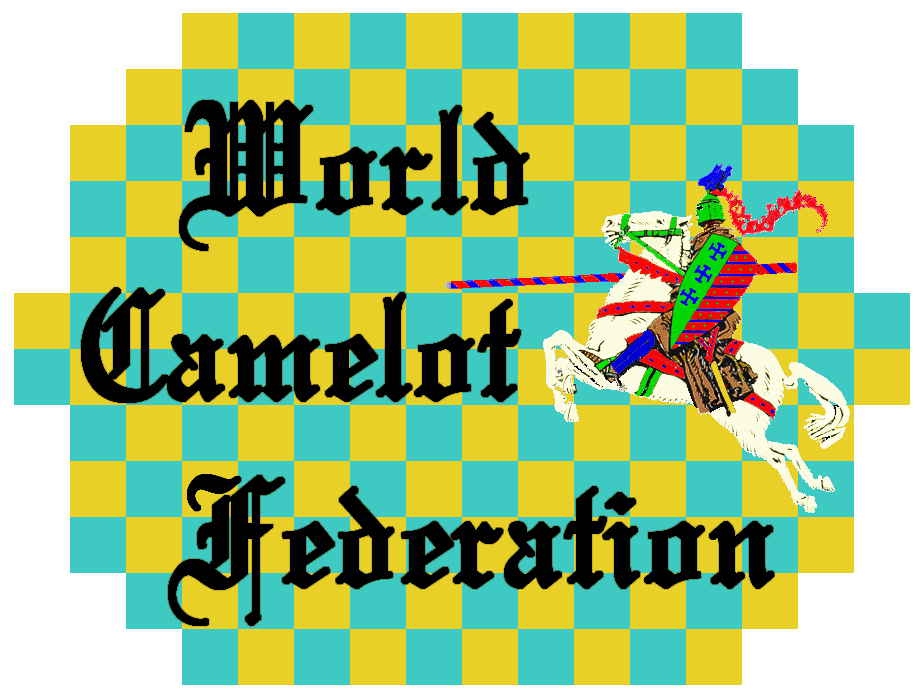
|
|
|
|
SUMMARY OF THE RULES OF CAMELOT In the Scots English Language
Text and Diagrams © 1999-2012 Michael Wortley Nolan and the World Camelot Federation Translation courtesy of Louise McTavish
(Please note that what follows is the translation of a general summary of Camelot rules; it is not a translation of the World Camelot Federation Official Rules of Camelot.)
Camelot is plàyed atwein 2 opponents wha alternate moves oan a baird ae 160 sqaures. Ilk plair defends a castle composed ae twa squares it his end ae the baird. Ilk plair stairts wae 14 piecaes : fower Kights an ten men.
The Stertin' Position
Thar ar fower types ae moves:
1. Plain Move: A piece (aither Knight ar Man) kin move wan square in any direction tae any adjacent impty square.
The Plain Move
2. Canter: A piece (aither Knight ar man) kin leap in any direction aiver a friendly piece thit occupies an adjacent square ontae an empty square immediately beyond it. Piecaes cantered air arenae removed. A plairr kin canter air mare thin wan piece durin' the same move. A plair cannae make a Canter thit begins and ends oan the same square. A plair is niv'r compelled tae canter.
The Canter Efter the Canter
3. Jump: A piece (aither Knight ar Man) kin leap in any direction aiver an oppisin' piece thit occupies an adjacent square ontae an empty square immediately beyond it. Enemy piecaes jumpit air are removed fae the baird. A plair must jump if wan ae his piecaes is nixt tae an exposed enemy piece. Huvin' jumpit air wan enemy piece, the jumpin' must continue if the plair's piece reaches a square nixt tae anair exposed enemy piece. A plair kin choose which opposin' piece tae capture, an wae whilk ae his piecaes tae make the capture. Whin compelled tae jump, a play may, if he kin, capture by a Kinght's Charge instaid. A plair kin ignore his obligation tae jump ainly if, oan his previous move, he's jumped wan ae his piecaes air an opponent's piece intae his ain castle. In thit case, he must immediately move thit piece oot fae his Castle.
The Jump Efter the Jump
4. Knight's Charge : A knight kin c'mbine a Canter an a Jump in a single move. A Kinght's Charge must follae the ordar ae first the Canter's an last the Jumps. A Knights is nivir obliged tae make a Knight's Charge. If the Canter ae a Knight brings it nixt tae an enemy piece thit kin be jumpit, it must dae so, unless later in thit same move it captures an enemy piece elsewhaur. Huvin' jumpit air wan enemy piece, the jumpin' must continue if the plairr's Knight reachaes a square nixt tae anithir exposed enemy piece.
The Knight’s Charge Efter the Knight’s Charge
A plair mustnae plain-move ar canter intae his ain Castle. A plair may jump, ar make the jumpin' portion ae a Knight's Charge, inta his ain Castle. If a plair jumps intae his ain Castle, he must continye the jumpin' oot ae his ain Castle. If a plair jumps intae his ain castle, he must continue the jumpin' ootae his ain Castle, if able. A plair wha his jumpit inta his ain Castle must, oan his nixt turn, move oot fae his Castle, wi nae excpetion. A plair movin' oot fae his ain Castle must jump oot, if possible, instead ae plain-moving ar canterin' oot.
A piece thit hus entered his opponent's Castle cannae come oot, bit is allowed tae move fae wan Caste square tae anither. The plair is limitaed tae twa Castle Moves durin' a game.
The game Kin be wan in three difrin waiys:
1. A plair moves twa ae his piecaes intae his opponent’s Castle.
White wins by movin' twa piecaes intae Black’s Castle
2. A plair captures aw ae his opponent’s piecaes, an hus twa ir mare ae his ain piecaes left.
White wins by capturing aw ae Black’s piecaes
3. A plair hus twa ir mare piecaes, an his opponent isnae able tae mak' a legal move.
White wins beckis Black hus nae legal move
The game is drawn if baith plairs have nae mare than wan piece left.
Draw
|